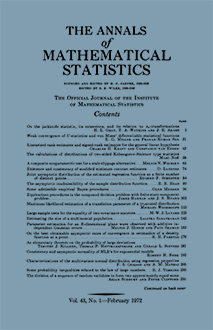Abstract
There are given a populations $\Pi_1, \cdots, \Pi_a$, of which we wish to select a subset. The quality of the $i$th population is characterized by a real-valued parameter $\theta_i$, and a population is said to be \begin{align*}\tag{1} positive \quad \text{(or} \quad good) \quad \text{if} \quad \theta_i &\geqq \theta_0 + \Delta, \\ \tag{2} negative \quad {(or} \quad bad) \quad \text{if} \quad \theta_i &\leqq \theta_0,\end{align*} where $\Delta$ is a given positive constant and $\theta_0$ is either a given number or a parameter that may be estimated. A number of optimum properties of selection procedures are defined (Section 3) and it is shown that for some of these, the optimum procedure selects $\Pi_i$ when \begin{equation*}\tag{3}T_i \leqq C_i,\end{equation*} where $T_i$ is a suitable statistic, the distribution of which depends only on $\theta_i$, and where $C$ is a suitable constant. (Sections 4 and 6.) Applications are given to distributions with monotone likelihood ratio in the case that $\theta_0$ is known (Sections 5 and 6), and to normal distributions when instead observations on $\theta_0$ are included in the experiment (Sections 10 and 11).
Citation
E. L. Lehmann. "Some Model I Problems of Selection." Ann. Math. Statist. 32 (4) 990 - 1012, December, 1961. https://doi.org/10.1214/aoms/1177704841
Information





